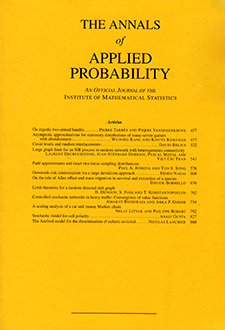Abstract
Consider a spiked random tensor obtained as a mixture of two components: noise in the form of a symmetric Gaussian p-tensor for and signal in the form of a symmetric low-rank random tensor. The latter is defined as a linear combination of k independent symmetric rank-one random tensors, referred to as spikes, with weights referred to as signal-to-noise ratios (SNRs). The entries of the vectors that determine the spikes are i.i.d. sampled from general probability distributions supported on bounded subsets of . This work focuses on the problem of detecting the presence of these spikes, and establishes the phase transition of this detection problem for any fixed . In particular, it shows that for a set of relatively low SNRs it is impossible to distinguish between the spiked and nonspiked Gaussian tensors. Furthermore, in the interior of the complement of this set, where at least one of the k SNRs is relatively high, these two tensors are distinguishable by the likelihood ratio test. In addition, when the total number of low-rank components, k, of the p-tensor of size N grows in the order as N tends to infinity, the problem exhibits an analogous phase transition. This theory for spike detection is also shown to imply that recovery of the spikes by the minimum mean square error exhibits the same phase transition. The main methods used in this work arise from the study of mean field spin glass models, where the phase transition thresholds are identified as the critical inverse temperatures distinguishing the high and low-temperature regimes of the free energies. In particular, our result formulates the first full characterization of the high temperature regime for vector-valued spin glass models with independent coordinates.
Funding Statement
The research of W.-K. Chen is partly supported by NSF Grants DMS-16-42207 and DMS-17-52184, and Hong Kong Research Grants Council GRF-14302515. The research of G. Lerman is partially supported by NSF Grants DMS-14-18386 and DMS-18-21266.
Acknowledgments
The authors thank the anonymous referees for providing many useful suggestions regarding the presentation of the paper and bringing an alternative approach of Section 2 to our attention.
W. K. Chen thanks the National Center for Theoretical Sciences and Academia Sinica in Taipei for their hospitality during his visit in June and July 2018, where part of the results and writings were completed. In addition, he is grateful to Lenka Zdeborová for many illuminating discussions.
Citation
Wei-Kuo Chen. Madeline Handschy. Gilad Lerman. "Phase transition in random tensors with multiple independent spikes." Ann. Appl. Probab. 31 (4) 1868 - 1913, August 2021. https://doi.org/10.1214/20-AAP1636
Information





